
PNGAA Library
The bone man of Aitape: Harry Roach

I had just finished the book The Bone Man of Kokoda, lent to me by that Aitape Big Man Robert Parer, when it occurred to me that I knew another Bone Man, Tadashi Nishibaki: the Bone Man of Aitape.
It was around 1968, when a young Japanese man walked into my office at Aitape, West Sepik District. I wondered at the time how he got there as I had not heard a plane. It turned out he had walked up from Wewak taking nearly a month to do so.
He could make himself understood in Tok Pidgin and he had been informed by the Japanese War files that his father, a senior officer in the Japanese Army, had been shot to death in the clean-up operations at the end of World War II. Records indicated he had been shot near the village of Malol just a few miles north of Aitape.
Tadashi was keen to search for details. Not giving him much hope, I took him to Malol and put him in the care of a good friend Brere Awol, the head man of Malol.
When Tadashi returned to Aitape some six days later he had an amazing story. He had sat down with elderly villagers, some of whom still had a smattering of Japanese, and explained his search. An old woman apparently remembered the incident and took Tadashi to the site where they began to search. Apparently there were no burials as the two Japanese remains were found where they fell.
He opened up his bag and out tumbled two skulls, dog tags, some bones and bit of uniform he had collected at the site! The dog tags were his father's and his father's batman; both skulls had a neat bullet hole in the forehead and various buckles and bits were obviously army issue!!
I remember the day he returned we had the Franciscan Mission pilots and Engineers to dinner. When Tadashi produced the bones and held up the skulls saying, ‘Good teeth! Good teeth!’ our guests felt it time to go home.
As he could not take bones back to Japan we burnt the bones to ash on a sheet of corrugated iron and Tadashi headed back to Japan and fame and fortune with appearances on TV shows and newspaper interviews.
He returned to Aitape a few months later escorting a multi-millionaire, Ryoshi Sashagawa, and we made arrangements to visit him at the end of 1968. However, I was selected to attend the 1969 ASOPA long course in Local Government and Tadashi married and moved and we lost touch.
In that year Tadashi hosted a visit to Japan by Michael Somare and, at different times, Rob Parer and Peter Williams. He even met with Japanese Royalty as his efforts were recognised by the Japanese public.
He returned and erected a large war memorial on Catholic Mission land at Wewak, dedicated to both allied and Japanese Soldiers killed in the war. He shipped a huge stone from Japan and, with Bishop Leo Arkfeld's approval and a little help, erected the memorial with the following inscription:
In memory of the brave soldiers who paid the supreme sacrifice for their counties Japan, Australia, America and New Guinea during World War ll from 1941 to 1945 and in sincere Hope that our men will never again engage in war, but a deep spirit of friendship may exist between us all. Then their sacrifice will not have been in vain.
Tadashi named his second son after Bishop Leo but with the limits of the Japanese pronunciation it came out as Ryo. For 35 years we lost touch: Tadashi had married and moved, letters I sent were returned, I was posted to Bougainville and finally returned to Australia.
Unknown to me the memorial was damaged and around 2003 Tadashi returned to Wewak to undertake repairs. Rob Parer was in Wewak, went to renew acquaintances and was asked if he knew where I was. Tadashi obtained my phone number and address.
He rang me as soon as he returned to Japan and was on the next plane to Australia! Still only speaking Tok Pidgin he took the town of Cooroy by storm. Sitting in the lotus position in his Kimono he held court at the Cooroy RSL on Australia Day 2004.
On ANZAC Day 2014 we lost him at the Rainbow Beach Surf Club, only to find him talking to two ex-RAAF wartime New Guinea Pilots he had convinced that he was a war time Zero pilot! He was born 5 March 1936.
Since then there has been a progression of visits: us to Japan three or four times for Cherry Blossom time and he and his family four or five times to Cooroy. We became very close and just farewelled Tadashi’s wife, Yoshie, in June 2015 after her last visit. She flew to Australia to nurse my wife Betty after a full hip replacement.
Sadly Tadashi passed away in late June but his memorial is still in Wewak and the story of him producing the skulls and dog tags of his lost father lingers on. He is well remembered in Cooroy, especially by those ex New Guinea Pidgin speakers for that is the only way he could converse with us at the RSL.
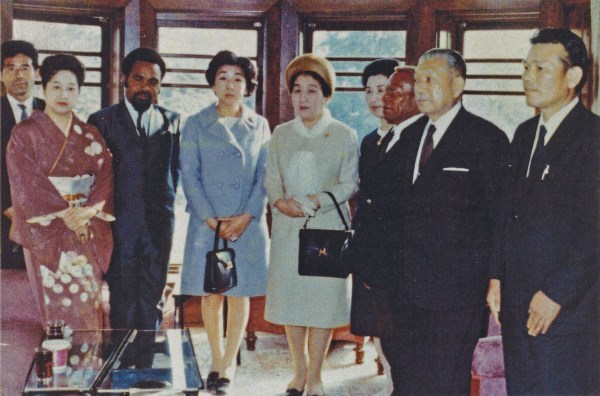
Tadashi as a young man (far left) with Michael Somare (third from left) and Japanese Royalty (two ladies in centre)
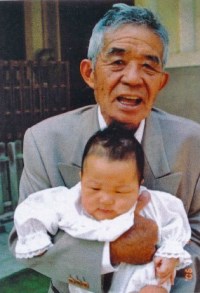
Tadashi as Cooroy knew him, with his first grandson, Yuna, about 6 years ago
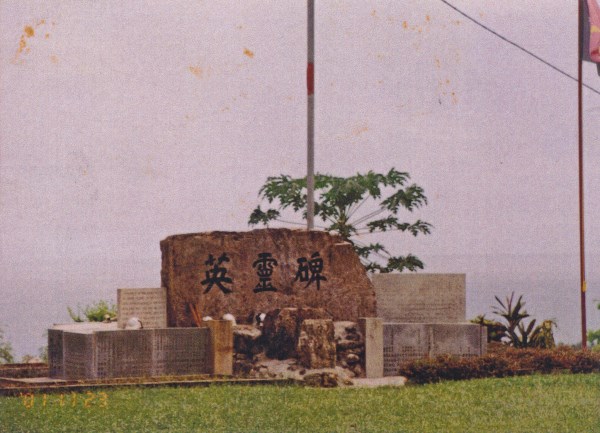
The completed war memorial as constructed on Catholic Mission land at Wewak around 1969
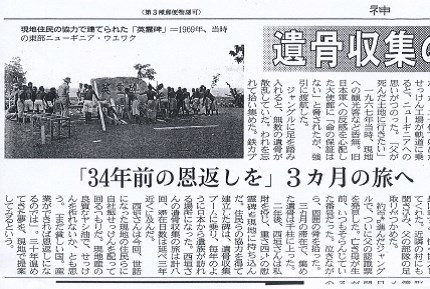
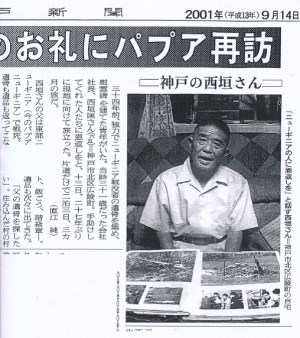
Cuttings from a Japanese newspaper that published the story and some photos